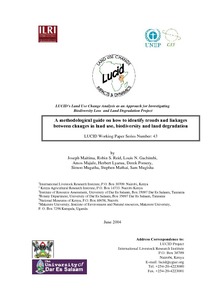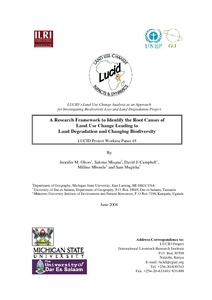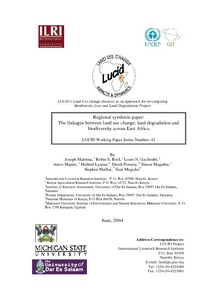The emergence and spreading of an improved traditional soil and water conservation practice in Burkina Faso
"This paper describes the emergence of improved traditional planting pits (zaï) in Burkina Faso in the early 1980s as well as their advantages, disadvantages and impact. The zaï emerged in a context of recurrent droughts and frequent harvest failures, which triggered farmers to start improving this local practice. Despair triggered experimentation and innovation by farmers. These processes were supported and complemented by external intervention. Between 1985 and 2000 substantial public investment has taken place in soil and water conservation (SWC).
The influence of social capital on sustainable agriculture in marginal areas in Kenya
Strategies for sustainable natural resource management
This brief describes two case studies as follows: "Sub-Saharan Africa, with the highest fertility rate in the world, faces increasing demographic pressure on its natural resource base.... Old strategies for coping with these new pressures on the natural resource base are becoming increasingly infeasible... Consequently, Africa's farmers require new solutions to address the increasing pressure on the continent's soil and water resources. Among hundreds of innovative efforts across the continent, two promising sets of responses have emerged in different locations....
Spatiotemporal mapping of the dry season vegetation response of sagebrush steppe
The vegetation dynamics of semi-arid and arid landscapes are temporally and spatially heterogeneous and subject to various disturbance regimes that act on decadal scales. Traditional field-based monitoring methods have failed to sample adequately in time and space in order to capture this heterogeneity and thus lack the spatial extent and the long-term continuous time series of data necessary to detect anomalous dynamics in landscape behavior.
Cercetari privind regenerarea sub masiv si introducerea la adapostul masivului a unor specii autohtone valoroase, in arborete apropiate de exploatabilitate, de pe terenuri degradate
Researches made in the most important part of protection plantations reforested on land degradation showed that the basic species is Pinus nigra and/ or Pinus silvestris replacing some stands with Hippophae associations. This stands have a fragile structure, not so good for protection functions. Sheltered regeneration and reforestation with local valuable species represents an efficient method for increasing the stability of stands in the reforestation of land degradation. In this way the degradation process was stopped and the vegetation was reinstalled.
A methodological guide on how to identify trends and linkages between changes in land use, biodiversity and land degradation
Linkages between changes in land use, biodiversity and land degradation in the Loitokitok area of Kenya
The linkages between land use change, land degradation and biodiversity across East Africa
Development pathways and land management in Uganda
This paper investigates the patterns and determinants of change in income strategies ("development pathways"), land management, resource and human welfare conditions in Uganda since 1990, based upon a community-level survey conducted in 107 villages. Six dominant development pathways were found, all but one of which involved increasing specialization in already dominant activities. Of these, expansion of banana and coffee production was most associated with adoption of resource-conserving practices and improvements in resource conditions and welfare.
Strategies for sustainable land management and poverty reduction in Uganda
The government of Uganda, with help from its development partners, is designing and implementing policies and strategies to address poverty, land degradation, and declining agricultural productivity. Land degradation, especially soil erosion and depletion of soil nutrients, is widespread in Uganda and contributes to declining productivity, which in turn increases poverty.











